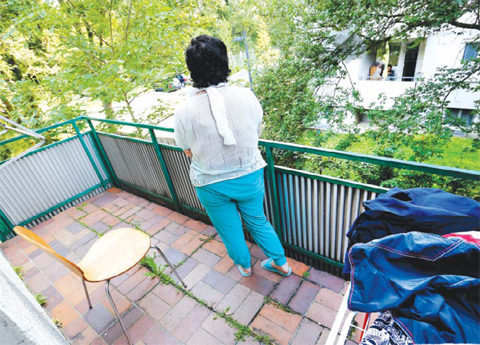 In this July 28, 2016 picture 17-year-old Yazidi girl stands on the balcony of her home. — AP
In this July 28, 2016 picture 17-year-old Yazidi girl stands on the balcony of her home. — AP
VILLINGEN-SCHWENNINGEN: The Yazidi girl had been in the safety of a refugee camp in Iraq for two weeks when she imagined she heard the voices of Islamic State fighters outside her tent. Petrified by the thought of again facing rape and abuse at their hands, 17-year-old Yasmin vowed to make herself undesirable. So she doused herself in gasoline and lit a match. The flames burned her hair and face, peeling away her nose, lips and ears. That was her state when German doctor Jan Ilhan Kizilhan found her in a refugee camp in northern Iraq last year - physically disfigured and mentally so scarred that she had falsely thought her former captors were coming for her.
Now 18, Yasmin is one of 1,100 women, mainly of the Yazidi religious minority, who have escaped IS captivity and are in Germany for psychological treatment. The pioneering program that Kizilhan helps run, which has attracted international attention, tries to address a basic problem: Long after the women are rescued, the trauma remains. Recalling her ordeal today, Yasmin hunches over in her chair, grips her gnarled hands together and looks down at the floor. But she straightens up and her face brightens as she remembers when Kizilhan first entered her tent in the refugee camp and told her and her mother, in their own language, how he could help in Germany.
Fear of reprisal
"I said, of course I want to go there and be safe, and be the old Yasmin again," she recounts. She asks that her last name not be used out of ongoing fear of possible reprisal from Islamic State sympathizers. It was on Aug 3, 2014, that IS fighters swept into the Sinjar region of northern Iraq, home to the majority of the world's Yazidis. They rounded up the Yazidis into three groups: Young boys who were made to fight for IS, older males who were killed if they didn't convert to Islam, and women and girls sold into slavery, like Yasmin.
Tens of thousands of Yazidis fled to the mountains, where the militants surrounded them in the scorching summer heat. The US, Iraq, Britain, France and Australia flew in water and other supplies, but many Yazidis died before they could be rescued. Following the IS assault, "no free Yazidis remained in the Sinjar region," a United Nations expert panel wrote. "The 400,000-strong community had all been displaced, captured or killed." An estimated 3,200 are still in IS captivity in Syria, where they were taken after being captured.
As the attack unfolded, members of the estimated 100,000-strong Yazidi community in Germany approached politicians in Berlin for help. Winfried Kretschmann, the governor of the prosperous western state of Baden Wuerttemberg, was moved and decided to act. "He asked us, 'what can we do?' We're a state, we don't have an army," recalls Michael Blume, the state's expert on minority issues. "We looked into it and said, no state's ever done it, but we could bring a special quota here."
The state parliament committed 95 million euros ($107 million) over three years to bring women abused by IS - mostly Yazidis but also Christians and Shiite Muslims - to Germany. Blume reached out to Kizilhan, a psychologist specializing in trauma and also a university professor and Mideast expert. Kizilhan, who is of Kurdish background, was born in Turkey and speaks Kurdish, including the Yazidi dialect, German, Turkish, Farsi, English and even some Arabic.
From February 2015 to January 2016, small teams of experts, including Blume and Kizilhan, went to refugee camps in northern Iraq. Kizilhan made 14 trips and personally interviewed the women and girls, trying to determine who would benefit best from the limited program. "It was an evil that I had never seen in my life," he says. "I'm experienced in trauma, I had already worked with patients from Rwanda, from Bosnia, but this was very different. If you have an 8-year-old girl in front of you and she's saying she was sold eight times by IS and raped 100 times during 10 months, how can humankind be so evil?"
Religious leader
In the end, he decided upon 1,100 women and girls ranging in age today from 4 to 56. Kizilhan and others then met with the head religious leader of the Yazidis, the Baba Sheikh, at the holy site of Lalish. He agreed not to ostracize the victims, despite the perceived affront to honor in their culture. "The Baba Sheikh talked with each one of them, kissed them on the head and said, 'You belong to our society, you are still Yazidis and we are very proud of you, that you could come through this kind of horror and torture back to our society,'" Kizilhan says. "Most of the women cried, very shocked but happy to be accepted by the highest priest."
The women are primarily treated in more than 20 clinics in Baden-Wuerttemberg, though 70 have been sent to Lower Saxony and another 30 to Schleswig Holstein. They are kept at undisclosed locations with extra security out of fears that IS sympathizers may try to target them even in Germany. The last chartered plane with the victims arrived in January.
The program is being closely watched, with many queries from other states and countries, Blume said. Kizilhan is also working on establishing a trauma institute in northern Iraq to provide similar services for those not fortunate enough to be brought to Germany. Kizilhan noted that even in refugee camps in Iraq, some 60 Yazidi women have committed suicide. About half the victims now in Germany need help just to stabilize. This means introducing them to the basics like going shopping, visiting doctors, and for children, going to school. - AP




